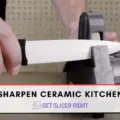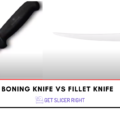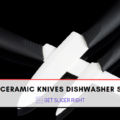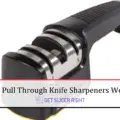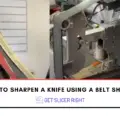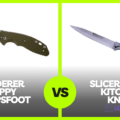Proper storage of kitchen knives is crucial for the longevity and performance of the knives and their safety. There are several methods to store knives, each with its own benefits, and choosing the right one depends on your kitchen space, budget, and personal preferences. From using knife blocks, magnetic strips, and drawer inserts to proper maintenance and care, storing knives appropriately can keep them sharp, safe, and readily accessible. Understanding these methods can help create a more efficient and safer kitchen environment.
Why It Is Necessary To Store Knives Properly?
- Storing knives properly is necessary to minimize the risk of accidental cuts or other injuries.
- Unsecured knives can be dangerous if handled by someone who doesn’t know how to use them correctly.
- Keeping your knives organized and stored securely will help ensure they are used safely and for their intended purpose.
- Proper knife storage also helps protect your blades from becoming damaged or dulled due to contact with other items in the kitchen.
- Storing knives properly can help improve your kitchen workspace’s overall safety and efficiency by eliminating potential clutter and keeping the area organized.
- It is important to store knives properly to prevent them from becoming dull or rusty due to exposure to moisture or air. This can help ensure that your knives remain sharp and effective for a longer period of time.
Types Of Knife Storage Solutions
Various types of knife storage solutions are available, each with unique features and benefits. In this section, we’ll explore five popular options.
- Knife blocks: Knife blocks are a classic and popular choice. They come in various materials, such as wood, bamboo, and stainless steel, and can accommodate different types and sizes of knives. Some knife blocks also have built-in sharpeners to keep your blades in top condition.
- Magnetic knife strips: Magnetic knife strips are a modern and space-saving solution. They can be mounted on a wall or inside a cabinet, keeping your knives visible, accessible, and off the counter. Select a high-quality strip with a strong magnet to ensure your knives stay put.
- Drawer knife organizers: If you prefer to keep your knives out of sight, drawer knife organizers are a great option. These inserts fit neatly into a drawer and have designated slots for knives. Choose an organizer that fits your drawer dimensions and can accommodate your knife collection.
- In-drawer knife blocks: In-drawer knife blocks blend traditional knife blocks and drawer organizers. They sit within a drawer and feature slots for your knives, like a typical knife block. This solution is perfect for those who want to save counter space while enjoying a knife block’s benefits.
- Knife rolls and cases: They are an ideal choice for those with limited storage space or who need to transport their knives frequently. These portable storage solutions protect your knives while keeping them organized and easily accessible.
How To Choose The Right Storage Solution?
There are several factors to consider when choosing the best knife storage solution for your kitchen. Let’s discuss four key considerations.
- Space considerations: Evaluate your kitchen space and determine how much room you have for knife storage. If you have limited counter space, opt for wall-mounted or drawer-based solutions.
- Accessibility: Consider how easily you need to access your knives while cooking. If you use them frequently, a wall-mounted or countertop option might be more convenient.
- Safety: Safety is paramount when storing knives. Ensure that the storage method you choose keeps the blades protected and away from curious little hands, especially if you have children in the house.
- Maintenance: Consider how easy cleaning and maintaining the storage solution is. Some materials, such as wood, may require more care than others, like stainless steel.
How To Store Knives In Your Kitchen?
- Invest in a quality knife block or Magnetic Knife Strip: This is the ideal way to store and protect your knives, as it keeps them secure and in one place. A wooden knife block in most kitchen stores is designed for holding several knives at once. Alternatively, magnetic strips are becoming increasingly popular for storing kitchen knives, as they keep the blades away from curious hands and provide a stylish display.
- Keep them sharp with regular honing: Regularly hone your knives to maintain a sharp edge, and use a sharpening stone every few months if necessary. To hone your knife, move it in small circles along the honing steel’s length, using the same angle each time. This will help keep your blades in top condition and reduce the risk of them becoming dull or damaged.
- Avoid leaving knives out on countertops: It is important to store kitchen knives away from curious hands and prevent them from becoming a hazard. Leaving knives out on countertops increases the risk of accidents and encourages them to become dull from frequent use.
- Clean knives immediately after use: Always wash and dry your kitchen knives as soon as you are done using them. Knives can corrode or rust over time if left wet, severely reducing their lifespan and effectiveness.
- Consider a knife storage solution: If you don’t have the space for a knife block or magnetic strip, plenty of other solutions exist. Drawer organizers, wall-mounted racks, and even kitchen sheaths can provide an effective way to store kitchen knives and keep them safe from harm.
FAQs
Do magnetic knife holders damage knives?
No, magnetic knife holders are not known to damage knives. Many professional chefs prefer them because they keep their knives secure and organized. However, it is important to note that keeping your knives on a magnet for an extended period of time can cause the metal in the blade to become magnetized, so be sure to remove your knives from the holder when not in use.
How do professional chefs store knives?
Professional chefs usually store knives in wooden blocks or magnetic strips. Wooden blocks keep the blades safe and secure while preventing them from becoming dull, which can be a real hazard when working with sharp objects.
What is a kitchen knife used for?
Kitchen knives are used for a variety of tasks in the kitchen. They can be used to cut, chop, slice, mince, and dice fruits, vegetables, meats, and other ingredients. Many specialized knives are available to make these tasks easier.
What are the parts of a knife?
A knife comprises several parts, including the blade, handle, bolster, and tang. The blade is the knife’s sharpened edge used for slicing and cutting food. The handle provides a comfortable grip when using the knife. The bolster helps secure the handle onto the blade and adds balance to the tool. The tang is part of the blade that extends into the handle. Understanding these parts will help you determine how to store and care for your knives properly.
Can I mix different brands or types of knives in one storage solution?
Yes, you can mix different brands and types of knives in one storage solution as long as the storage accommodates the various sizes and shapes.
How can I make sure my magnetic knife strip is secure?
When installing a magnetic knife strip, ensure it’s properly secured to the wall or cabinet using the appropriate mounting hardware. Always test the magnet’s strength with your heaviest knife before placing the entire collection on the strip.
Conclusion
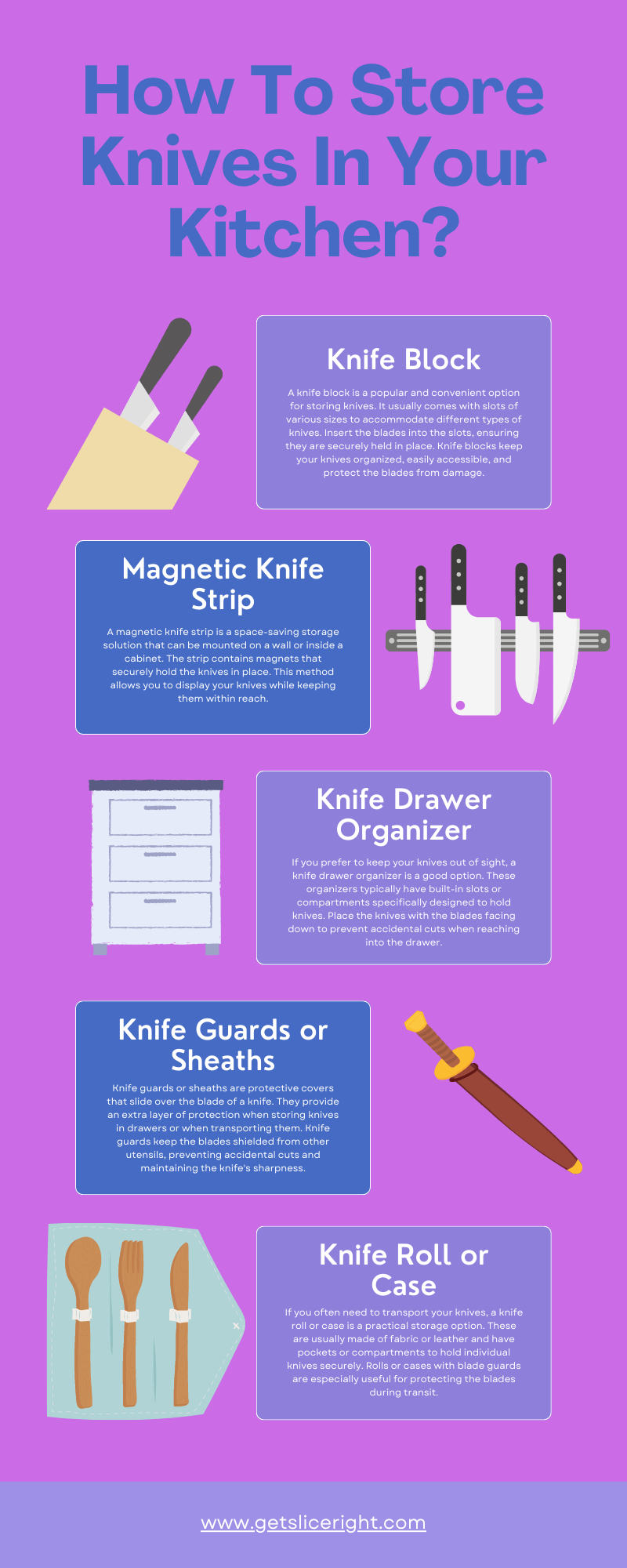
Proper knife storage is essential for maintaining the longevity, safety, and accessibility of your kitchen knives. Considering space, accessibility, safety, and maintenance, you can choose the right storage solution that fits your needs and keeps your kitchen organized.

Mario Batali is a renowned author, food enthusiast, and passionate chef who has dedicated his life to exploring the world of culinary arts. With a love for sharing his knowledge and experiences, Mario has become a prominent figure in the food blogging community, inspiring countless readers with his creativity and expertise.
In addition to his culinary prowess, Mario Batali is also a talented writer with a flair for engaging storytelling. He launched his own food blog to share his recipes, cooking tips, and personal experiences in the kitchen. Over time, Mario’s blog gained a loyal following of food enthusiasts who appreciate his unique approach to cooking and his dedication to using only the finest ingredients.
Mario Batali’s passion for food and his commitment to sharing his knowledge with others have made him a true inspiration in the world of culinary arts. Through his blog, cookbooks, and public appearances, Mario continues to spread his love of food and the joy of cooking with his ever-growing fanbase.

